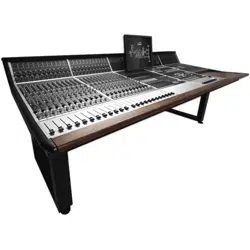Loading ...
Loading ...
Loading ...

INTRODUCTION
Recording is generally a three stage process
made up of the tracking stage, the editing stage
and then the mixing stage.
The tracking stage consists of capturing the
audio onto a storage medium. Traditionally
audio was captured onto multi-track tape,
however now the majority of people will use a
Digital Audio Workstation (DAW) such as Logic
or Pro Tools.
The editing stage involves preparing audio for
mixing, this usually involves everything from
trimming, editing and fading audio, to tuning
parts and more. This is where the monitoring
section of the console really comes into its own,
allowing you to quickly solo and cut channels
out of your monitoring mix.
The third stage of the process involves
returning the recorded tracks from your DAW/
tape machine back into the console. Using the
faders and EQs, you can mix the audio until the
individual tracks come together as a collective
whole. Once you are happy with your mix,
you can combine it into a stereo mix using the
analogue mix bus processing of the ASP8024-
HE.
Summing can also be done in your DAW
but you may nd that summing through the
console adds a little more colour and punch to
the overall mix, especially when fed through
the discrete 990 op-amps and Heritage Card
tonal options.
INLINE ARCHITECTURE
The ASP8024-HE uses an inline architecture,
which means the Mic/Line Inputs and the
DAW/Tape Returns are both situated on the
same channel strip; these two paths are known
as the Short Fader (SF) and the Long Fader (LF)
paths.
Inline architecture allows you to split the
various sections of the channel strip between
the two signal paths. For example, you could
use the Shelf EQs to add a high frequency
boost to a vocal during tracking and then use
the Cue sends to send the same Mic/Line
signal to a fold-back mix. At the same time you
could be using the Parametric EQs to cut out a
room noise on the DAW/Tape Return path and
using one of the Auxiliaries to send the DAW/
Tape return signal to a reverb unit.
To split the channel strip, each section has a
button which allows you to place it on either
the LF path or the SF path. The bus routing
switches by default are on the SF path, while
the Auxiliaries, Cues and EQs default to the LF
path. Furthermore, it is possible to ip the two
signal paths so that Mic/Line signal is sent to
the LF path and the Daw/Tape Returns are sent
to the SF path.
TRACKING
GETTING STARTED
A new project usually starts off with a blank
session in your DAW or with a blank roll of
tape. The rst step is to get a signal into the
console from the microphone or instrument. To
do this, connect the microphone or instrument
to the Mic/Line Inputs of your console. If you
are using the TRS Line Input, press down the
Line button on the channel you are using. If
you are using a microphone that requires +48V
Phantom Power then make sure that the red
‘+48V’ button is engaged. You should always
mute that channel, and your Speaker and
Headphone Outputs before engaging Phantom
Power as there can be a loud popping noise.
By default, the large Channel Meters show the
level of the LF path, pressing the MTR button
will ip this to allow you to accurately see the
level of the inputs. To set the level, turn the
Gain Knob, making sure to avoid overloading
the channel (indicated with the OVER light
above the meter).
34
Using asp8024-HE
Loading ...
Loading ...
Loading ...
